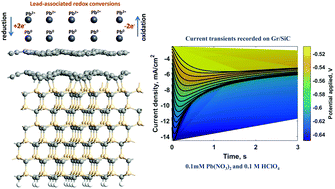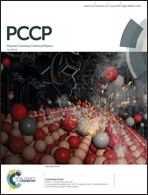Lead (Pb) interfacing with epitaxial graphene†
Abstract
Here, we report the electrochemical deposition of lead (Pb) as a model metal on epitaxial graphene fabricated on silicon carbide (Gr/SiC). The kinetics of electrodeposition and morphological characteristics of the deposits were evaluated by complementary electrochemical, physical and computational methods. The use of Gr/SiC as an electrode allowed the tracking of lead-associated redox conversions. The analysis of current transients passed during the deposition revealed an instantaneous nucleation mechanism controlled by convergent mass transport on the nuclei locally randomly distributed on epitaxial graphene. This key observation of the deposit topology was confirmed by low values of the experimentally-estimated apparent diffusion coefficient, Raman spectroscopy and scanning electron microscopy (SEM) studies. First principles calculations showed that the nucleation of Pb clusters on the graphene surface leads to weakening of the interaction strength of the metal–graphene complex, and only spatially separated Pb adatoms adsorbed on bridge and/or edge-plane sites can affect the vibrational properties of graphene. We expect that the lead adatoms can merge in large metallic clusters only at defect sites that reinforce the metal–graphene interactions. Our findings provide valuable insights into both heavy metal ion electrochemical analysis and metal electroplating on graphene interfaces that are important for designing effective detectors of toxic heavy metals.



 Please wait while we load your content...
Please wait while we load your content...